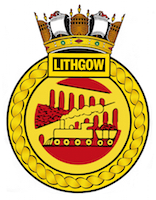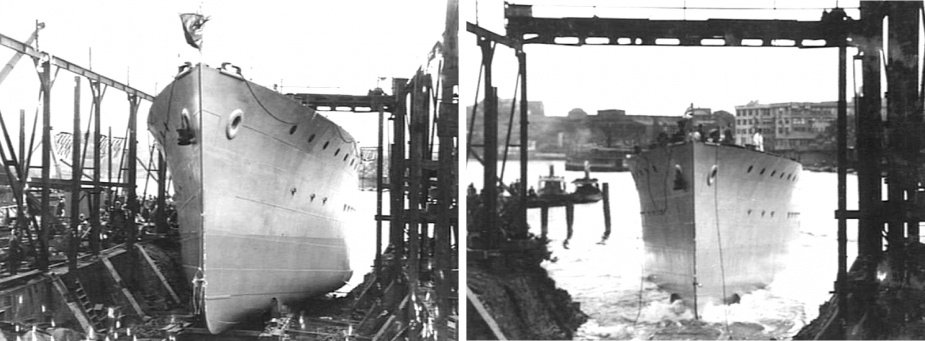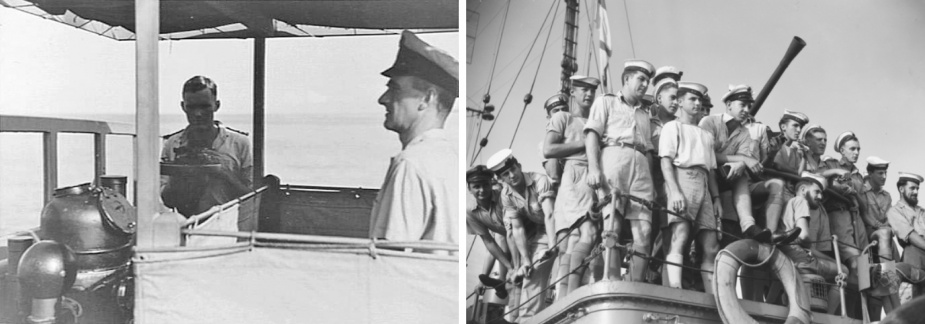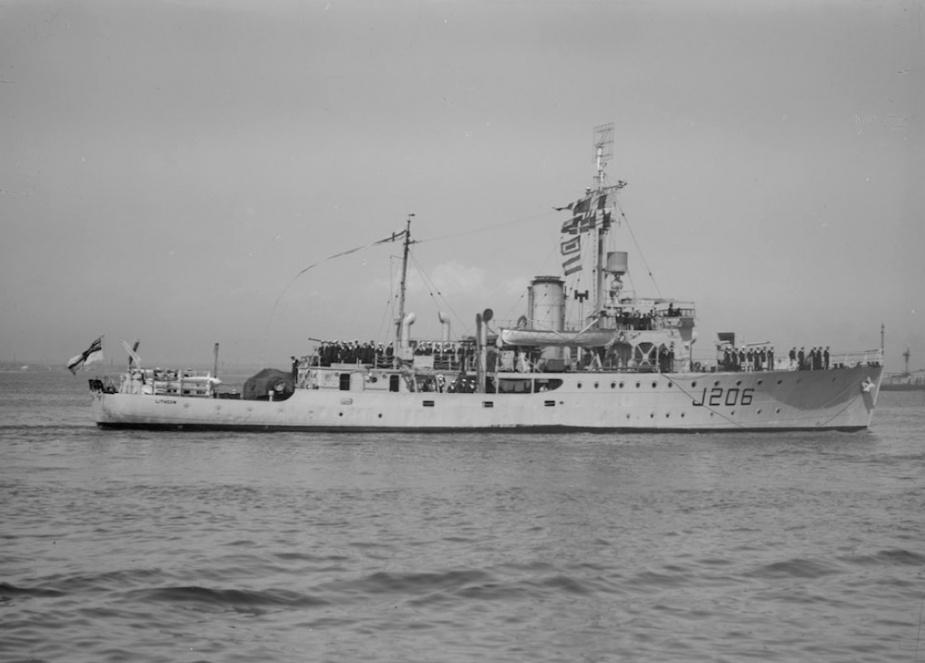HMAS Lithgow
| Class |
Bathurst Class |
|---|---|
| Type |
Australian Minesweeper |
| Pennant |
J206 |
| Builder |
Mort's Dock & Engineering Co Ltd, Sydney |
| Laid Down |
19 August 1940 |
| Launched |
21 December 1940 |
| Launched by |
Mrs Bennett, wife of a Director of Mort's Dock and Engineering Co Ltd |
| Commissioned |
14 June 1941 |
| Decommissioned |
8 June 1948 |
| Dimensions & Displacement | |
| Displacement | 650 tons |
| Length | 186 feet |
| Beam | 31 feet |
| Draught | 10 feet |
| Performance | |
| Speed | 15 knots |
| Complement | |
| Crew | 85 |
| Propulsion | |
| Machinery | Triple expansion, 2 shafts |
| Horsepower | 1750 |
| Armament | |
| Guns | 1 x 4-inch gun |
| Other Armament | 3 x Oerlikons |
| Awards | |
| Battle Honours | |

HMAS Lithgow was one of sixty Australian Minesweepers (commonly known as corvettes) built during World War II in Australian shipyards as part of the Commonwealth Government’s wartime shipbuilding programme. Twenty were built on Admiralty order but manned and commissioned by the Royal Australian Navy. Thirty six (including Lithgow) were built for the Royal Australian Navy and four for the Royal Indian Navy.
HMAS Lithgow was laid down at Morts Dock Engineering Company, Balmain, Sydney, NSW on 18 August 1940. She was launched on 21 December 1940 by Mrs Bennett, wife of a Director of Mort’s Dock and Engineering Co Ltd and was the first RAN warship to carry the name of the city in the central tablelands of NSW. By the war’s end Mort’s Dock had constructed fourteen of the sixty Bathurst Class corvettes.
HMAS Lithgow commissioned at Sydney on 14 June 1941 under the command of Commander Alfred V Knight DSC, RANR(S).
HMAS Lithgow began her active career in July 1941 as a unit of the 20th Minesweeping Flotilla sweeping in Bass Strait and Tasmanian waters. Twenty German mines were swept by the Flotilla in 1941, Lithgow accounting for one of these off Tasman Island on 14 October.
The outbreak of the Pacific War ended sweeping operations for Lithgow and she temporarily assumed anti-submarine patrols off Sydney, before proceeding in January 1942, escorting the first US convoy to Darwin where she passed to the control of the Darwin command.
On 20 January 1942 Lithgow took part in the destruction of the Japanese minelaying submarine I-124, officially credited to HMA Ships Deloraine (I), Lithgow and Katoomba (I), and USS Edsall.
Escorting of Darwin-Thursday Island convoys occupied Lithgow until September 1942 when on the 18th she departed Townsville escorting a troop convoy of three ships for Port Moresby. The remainder of the year was taken up protecting New Guinea convoys. In December she took part in the landing of troops and equipment at Oro Bay for the Buna campaign. On 30 December 1942, on completion of more than 18 months service, Lithgow put into Brisbane for refitting.
The refit was completed on 5 March 1943 and the following day Lithgow began nine months of escort and anti-submarine duty on the Queensland coast. At around 12:30 on the morning of 19 December 1943, Lithgow was diverted from her own convoy escort duties to render assistance to convoy TN 192. Seven of the eight merchant vessels in the convoy, along with one of the escorts, HMAS Gladstone (I), had run aground on Bougainville Reef on the Great Barrier Reef. By the time Lithgow arrived just before 6:00 that morning, Gladstone had managed to refloat herself and was waiting for daybreak in company with the other convoy escorts, HMA Ships Gympie (I) and Stawell (I), just clear of the reef. The vessels Colorado, Ambrose Bierce and City of Fortworth had also all managed to free themselves and, with Lithgow and HMAS Castlemaine arriving to assist, and her own starboard propeller damaged, Gladstone detached at just after 7:00am to escort the trio back to Cairns.
Lithgow, along with Gympie, Stawell and Castlemaine, began disembarking troops from the stricken vessels at just after 9:00am. With all the troops transferred by 11:30 that morning, Lithgow began escorting those ships that were able to proceed back to Cairns early in the afternoon, arriving at around 7:00 that evening and subsequently returned to her own escort duties. All of the remaining ships were quickly refloated suffering varying degrees of damage.
The year of 1944 began with escort duties to New Guinea, followed by the ship’s annual refit at Melbourne. In April Lithgow arrived at Milne Bay to begin a period of ten months escort and anti-submarine operations in New Guinea waters. She was in constant service to Langemak, Hollandia, Madang, Wakde, Biak, Morotai, Noemfoor and Mios Woendi.
A seven week refit at Williamstown in April and May 1945 was followed by a return to New Guinea waters. In June and July the ship took part in Allied operations in the Solomons, supporting the land forces with a series of bombardments against enemy held territory. Lithgow remained based on the Solomons until the end of September 1945, operating as a minesweeper in the latter period. She was present at the Japanese surrender at Rabaul. October was spent in New Guinea waters, the ship ending her active war career when she entered Sydney Harbour on 1 November 1945.
In 1946 and 1947 Lithgow operated as a unit of the 20th Minesweeping Flotilla. She was constantly employed on minesweeping duties, in 1946 in the New Britain/Solomons area and on the Queensland coast the following year. Her seagoing career ended in January 1948 when she arrived at Fremantle, finally paying off into the Reserve Fleet on 8 June 1948, having steamed 178,000 miles and being under way for almost 20,000 hours.
On 8 August 1956 Lithgow was sold as scrap to the Hong Kong Delta Shipping Company, Hong Kong.
Note: This video is hosted on YouTube. Department of Defence users will not be able to view this video on the Defence Protected Network.
This cine film has been placed online as part of the Sea Power Centre - Australia’s ongoing archival digitisation program.
Further Reading
- The Corvettes: Forgotten Ships of the Royal Australian Navy, by Iris Nesdale - published by the author, October 1982.
- Corvettes - Little Ships for Big Men, by Frank B Walker - published by Kingfisher Press, NSW, 1996.

















